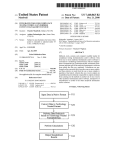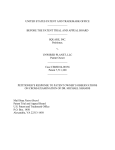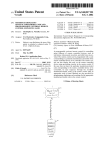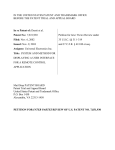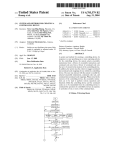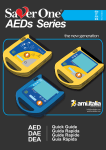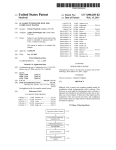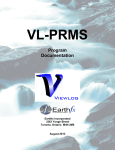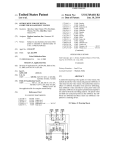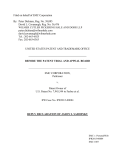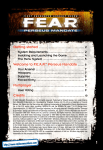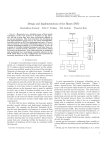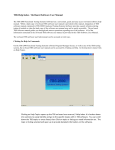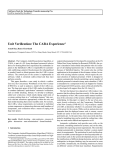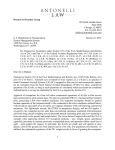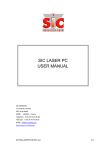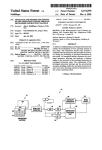Download RECORD OF ORAL HEARING
Transcript
[email protected] 571-272-7822 Paper 32 Entered: 6 May 2014 UNITED STATES PATENT AND TRADEMARK OFFICE ____________ BEFORE THE PATENT TRIAL AND APPEAL BOARD ____________ UNIVERSAL REMOTE CONTROL, INC. Petitioner, v. UNIVERSAL ELECTRONICS, INC. Patent Owner. ____________ Case IPR2013-00127 Patent 6,587,067 ____________ Before: SALLY C. MEDLEY, HOWARD B. BLANKENSHIP, and WILLIAM V. SAINDON, Administrative Patent Judges. RECORD OF ORAL HEARING APPEARANCES: ON BEHALF OF THE PETITIONER: TIMOTHY E. BIANCHI, ESQUIRE Schwegman, Lundberg, Woessner 1600 TCF Tower, 121 South 8th Street Minneapolis, Minnesota 55402 Case No. IPR2013-00127 Patent No. 6,587,067 and THOMAS C. REYNOLDS, ESQUIRE Schwegman Lundberg, Woessner 150 Alamaden Boulevard, Suite 750 San Jose, California 95113 ON BEHALF OF PATENT OWNER: MICHAEL NICODEMA, ESQUIRE Greenberg Traurig, LLP 200 Park Avenue Florham Park, New Jersey 07932-0677 and ERIC J. MAIERS, ESQUIRE Greenberg Traurig, LLP 77 West Wacker Drive, Suite 2500 Chicago, Illinois 60601 The above-entitled matter came on for hearing on Tuesday, April 8, 2014, commencing at 12:59 p.m., at the U.S. Patent and Trademark Office, 600 Dulany Street, Alexandria, Virginia. 2 Case No. IPR2013-00127 Patent No. 6,587,067 1 PROCEEDINGS 2 3 - - - - JUDGE MEDLEY: Good afternoon. This is the hearing 4 for the IPR2013-00127 between Petitioner Universal Remote Control 5 and Patent Owner Universal Electronics, Incorporated. 6 7 At this time we would like the parties to please introduce counsel starting with the Petitioner. 8 9 10 MR. BIANCHI: Your Honor, I'm Timothy Bianchi for Universal Remote Control and this is my co-counsel, Thomas Reynolds. 11 12 JUDGE MEDLEY: Okay. Mr. Bianchi, will you be arguing today? 13 MR. BIANCHI: Yes. 14 JUDGE MEDLEY: Thank you. And then for Patent 15 Owner? 16 17 MR. NICODEMA: Good afternoon, Your Honor. Michael Nicodema for UEI, along with my partner, Eric Maiers. 18 19 20 JUDGE MEDLEY: Mr. Nicodema, will you be arguing today? MR. NICODEMA: Yes, Your Honor. I will be presenting 21 UEI's main argument. Mr. Maiers will be arguing our pending motion 22 to exclude a portion of Dr. Herr's testimony. 23 24 JUDGE MEDLEY: Okay. Thank you. Each party will have 30 minutes total time to present their arguments. Petitioner will 3 Case No. IPR2013-00127 Patent No. 6,587,067 1 begin with the presentation of its case with regard to challenged 2 claims on which basis the Board instituted trial. 3 Thereafter, Patent Owner, you will respond to Petitioner's 4 presentation and then, Petitioner, you may reserve rebuttal time to 5 respond to Patent Owner's presentation. 6 7 8 9 10 11 12 Petitioner, you may begin and how much time would you like to reserve, if any? MR. BIANCHI: Your Honor, would you like paper copies of the presentation for today? JUDGE MEDLEY: Yes, please, if you -- you may approach the bench. Thank you. MR. BIANCHI: Your Honor, we would like to reserve 15 13 minutes for rebuttal. I'd also like to leave open the option that Mr. 14 Reynolds be allowed to argue on rebuttal, if necessary. 15 JUDGE MEDLEY: That's fine. 16 MR. BIANCHI: Okay. 17 JUDGE MEDLEY: You may proceed. 18 MR. BIANCHI: Thank you, Your Honor. I appreciate that. 19 In our case today we would like to drive home two major points about 20 the IPR. The first point that we'd like to make is that all through -- all 21 of the testimony that's been developed and all of the documents of 22 record, to this date Patent Owner still has not proved a date of 23 invention earlier than the prior art references, and we'll talk a little bit 24 more about those prior art references in the upcoming slides. 4 Case No. IPR2013-00127 Patent No. 6,587,067 1 I'm referring now to slide/page number 2 of your materials. 2 So, in brief, what we're arguing is that the Patent Owner has not 3 produced evidence of the invention working for its intended purposes. 4 There are some very phaseal statements to that effect in the record, 5 but there is no evidence of testing. 6 The second point we would like to make is that the prior art 7 does show all of the key features as characterized by Patent Owner, 8 for example, the direct entry method of matching remote -- the remote 9 to appliances of different manufacturers and also the assigning a 10 command macro to a macro pushbutton. 11 I refer now to page 3 of the materials. What we put on this 12 page are some of the dates of interest, including the priority date for 13 the '067 patent, which was filed on October 14, 1987. There are also 14 relevant dates to the prior art that we have used in our petition and as 15 is instituted in this proceeding for trial. 16 And of those different references, I would just like to note 17 that at no time has the Patent Owner attempted to antedate the 18 Rumbolt reference, which is the last one listed there back to 19 November 20, 1985. I want to make that perfectly clear. We also 20 want to remind the Board that in its Institution Order that it attributed 21 to the CORE user manual, which is the first prior art reference listed 22 there, September 1, 1987 based on some additional publications in the 23 record. 24 25 At no time did Patent Owner also show -- attempt to show conception and then diligence, so this is strictly a case of where Patent 5 Case No. IPR2013-00127 Patent No. 6,587,067 1 Owner is asserting an actual reduction of practice prior to our prior art 2 references. 3 Moving on to page 4. So perhaps the most important 4 argument points are that in general what we are saying to the Board is 5 that the Patent Owner's reduction to practice proof fails for several 6 reasons. The first reason, all evidence essentially comes from 7 co-inventors. There's no independent corroboration of the evidence 8 asserted. 9 The second reason is that specific dates are lacking. We're 10 given very ambiguous ranges of dates in all of the materials. So the 11 dates are lacking and indication of features and differences between 12 the three prototypes referenced by Co-Inventor Ellis are lacking a 13 description of the differences. 14 As we stated earlier, there's also no evidence of testing, 15 which the Board expressly noted in its order instituting trial. And, 16 finally, we want to point out that the patented invention was 17 admittedly software-based, yet the vast majority of the exhibits 18 attached to Patent Owner's response include printed circuit board 19 information, things relating to the circuits that don't necessarily affect 20 the software. 21 In general, what happened here is that Patent Owner was 22 asked to provide evidence of testing and that it worked -- that the 23 design that was claimed worked for its intended purpose, but all we 24 have are some bald statements made by the Patent Owner -- their 25 expert, I'm sorry, by Patent Owner's expert in testimony by Ellis. 6 Case No. IPR2013-00127 Patent No. 6,587,067 1 I'm referring now to page 5 of the slide deck. So let's talk 2 about independent corroborating evidence. All the evidence relied on 3 in this -- in Patent Owner's response relates to proving reduction to 4 practice based on Exhibits A through T, which are again largely 5 directed to the hardware, and then there's a declaration by Mr. Ellis, 6 Co-Inventor Ellis. 7 Much of that evidence the Board had already seen when it 8 instituted trial. For example, Patent Owner attempted to swear behind 9 the prior art references using a 131 declaration that was included in a 10 different related application. The Board expressly rejected that 11 approach because of the adjudicatorial nature of these proceedings 12 vis-à-vis examinatorial nature. 13 We believe the Board was correct to do that. Many of the 14 exhibits that are added after that were either prepared by co-inventors 15 or have a questionable origin based on the fact that the Co-Inventor 16 Ellis, who was deposed, did not have those documents in his 17 possession. 18 In order to establish an actual reduction to practice, an 19 inventor's testimony must be corroborated by independent evidence. 20 That independent evidence is largely lacking in this evidence 21 proffered by Patent Owner. 22 Moving on to slide number 6. The dates that Co-Inventor 23 Ellis provided in deposition and in his declaration are ambiguous. 24 The allegations regarding reduction to practice in his declaration are 25 vague as to time. For example, the first prototype built sometime in 7 Case No. IPR2013-00127 Patent No. 6,587,067 1 the fall of 1986, the development prototype built sometime in the 2 winter of '86 to '87, pre-production model built sometime in March to 3 April 1987. Very little detail was given about these different 4 prototypes. 5 Now, Co-Inventor Ellis identified two key features of the 6 patent relating to direct entry method of matching a remote to 7 appliances of different manufacturers and assigning a command 8 macro to a macro pushbutton. As to when the direct entry was first 9 incorporated into the prototype, Ellis testified, It had to be early on, 10 but I don't have a specific date. As to when assigning a macro to 11 macro pushbutton was first incorporated to the working prototype, 12 Ellis testified, again, I don't know for sure. 13 Moving on to page number 7. So UEI failed to provide 14 evidence that the prototypes were tested and worked for their intended 15 purpose. Corroboration of an existence of a device itself is not 16 sufficient to establish reduction to practice. It is also necessary to 17 corroborate that the device worked for its intended purpose. And as a 18 result, UEI failed to prove that their software invention, which is what 19 Ellis testified to, is the nature of the subject matter to claims in the 20 patent challenge. The software invention was not shown to be tested 21 or that it worked for its intended purpose. 22 The only thing that Ellis stated is that it was suitable for its 23 intended purpose, but there was no corroborating other evidence other 24 than what he presented as Exhibits A through T, which as we said 25 earlier was generated largely by the inventors themselves. 8 Case No. IPR2013-00127 Patent No. 6,587,067 1 Moving on to page number 8. Really, as we said earlier, 2 Co-Inventor Ellis admitted that the invention largely relates to 3 software. The only piece of evidence relating to software of detailed 4 nature is the software code listed in the exhibit. The patented 5 invention being software-based, it's very important for that exhibit to 6 show that the software was indeed whole and working. 7 Even if all the evidence regarding the hardware was found 8 to be credible and the Board ignored our request to consider the lack 9 of proof of testing, reduction to practice could not possibly be 10 attributed to a date earlier than April 30, 1987, which is the date of the 11 source code printout. 12 And in that case, if that were to be the case, we strongly 13 advocate that the Board consider our arguments that there is not 14 testing provided, which should that be the case, the unpatentability of 15 Claims 1, 3, 4 and 6 based on the combination of Rumbolt and 16 Magnavox would still stand. 17 I think it's important to note that the mere fact that software 18 existed on a certain date did not mean that the invention worked for its 19 intended purpose, so there may have been a revision of code, but that 20 the code was not complete, and hardware without software that has a 21 completed code is inoperable. The mere fact that modules were edited 22 on certain dates do not indicate that they were suitable for the 23 intended purpose or that they were complete. 24 25 Moving on to page number 9. So now turning to the second part of the discussion today, Claim 1, what we did is we highlighted 9 Case No. IPR2013-00127 Patent No. 6,587,067 1 the different portions of what Patent Owner attributed to be key 2 features. Firstly, the directly identified aspect and then the assigning 3 macro pushbutton aspect. I'm going to page 10 of the materials. 4 Just as a preliminary note, the patent has expired, so 5 amendments are not even possible in this situation and basically what 6 we have in claim construction is a Markman decision by the Court, 7 the parallel concurrent litigation. That Markman decision occurred 8 days after we submitted our original petition and we submitted a 9 supplemental petition per the request of the Board and under -- having 10 contacted the Board to indicate the situation, we were given the option 11 of either submitting the original petition as is with the indicated 12 changes or getting a new filing date and we opted for the former. 13 So in its response, Patent Owner advocates for a special 14 definition of library of codes and data to mean a table programmed 15 into the remote control, the table comprising a variety of command 16 codes corresponding to a particular appliance of different 17 manufacturers. 18 This was raised for the first time after the Board's 19 institution. We believe that this was an attempt to differentiate from 20 the prior art, because the Board had already decided in its order to 21 institute that the number of times that whether the codes were 22 pre-programmed or not was not required by the claim language itself. 23 It should not matter how the codes were programmed into the remote, 24 because the claims do not require a certain pre-programming step per 25 se. 10 Case No. IPR2013-00127 Patent No. 6,587,067 1 2 I believe I'm coming close to the end of my 15 minutes, Your Honor. Do you have the time remaining? 3 JUDGE MEDLEY: Yeah, one minute. 4 MR. BIANCHI: One minute. So just to summarize and 5 finish up the last few slides, we believe that the prior art was correctly 6 noted as -- by the Board as concluding the key features of the alleged 7 invention as deemed by Patent Owner. We believe that the prior art 8 references show obviousness of the claimed invention and we ask that 9 the Board cancel Claims 1 through 6 for obviousness under the 10 proffered grounds, and I will reserve the rest of my time for rebuttal. 11 JUDGE MEDLEY: Thank you. 12 Okay. Patent Owner. 13 MR. NICODEMA: Your Honor, does our 30 minutes 14 include the argument on our motion? 15 JUDGE MEDLEY: Yes. 16 MR. NICODEMA: It does? 17 JUDGE MEDLEY: Yes. 18 MR. MAIERS: May I approach? 19 JUDGE MEDLEY: Yes. Thank you. 20 Okay. So you have till 1:47. 21 MR. NICODEMA: Thank you, Your Honor. 22 Your Honor, there are three reasons why the Petitioner has 23 failed to carry its burden of proving Claims 1 through 6 of the '067 24 patent to be obvious. One is that we've shown through at least the 25 software code, which I will discuss, that the date of invention for 11 Case No. IPR2013-00127 Patent No. 6,587,067 1 Claims 1 to 6 precedes all of Petitioner's prior art except Rumbolt. 2 And because of that, all of their combinations must fail. 3 Secondly, with respect to the combinations of prior art that 4 include Rumbolt and Magnavox, the disclosures of those references in 5 addition to the testimony of UEI's expert, Mr. Hayes, show that 6 Rumbolt teaches away from a combination where pushbuttons would 7 be used in place of the DIP switches that are disclosed in Rumbolt, 8 and, third, even though there was motivation in the art to combine the 9 references as proposed by the Petitioner, there would still be at least 10 11 one and sometimes two claim elements lacking. Now, I'd like -- on the prior invention we submitted lots of 12 slides and I'm going to try to cut to the chase here, Your Honor. 13 Petitioner's own brief, and I believe Petitioner repeated this in his 14 argument just now, Petitioner's reply brief of page 7 says, if the Board 15 is inclined to consider the software code as evidence, then CORE, 16 Wozniak and Evans would be eliminated as prior art references. 17 Now, in making that statement, Petitioner relies upon the 18 date on the face of the software code, the April 30, 1987 date, but the 19 code itself shows that all the critical functions to the claims were 20 reduced to practice by March 24, 1987, which also would eliminate 21 Magnavox as prior art. And if that's the case, then all of the 22 Petitioner's combinations must fail, because we have demonstrated a 23 prior invention. 24 25 Now, on the issue of corroboration, Your Honor, it's UEI's position that the Petitioner is attempting to hold us to an artificially 12 Case No. IPR2013-00127 Patent No. 6,587,067 1 high standard, and if we look at slide 11 in our presentation, we have a 2 quotation from the Federal Circuit's decision in Price v. Symsek, and 3 that decision basically says, corroboration is not necessary to establish 4 what a physical exhibit before the Board includes, and in that case 5 documentary evidence was at issue. 6 Now, the Petitioner concedes that the software code 7 discloses all the critical limitations of the claims. They did not file 8 any objections, which I believe they were compelled to do, file 9 evidentiary objections on the admissibility of the software code. 10 11 JUDGE MEDLEY: Can you direct us to where they concede that all the elements are shown in the source code? 12 13 MR. NICODEMA: Yes. We can look at -- we can go through them slide by slide. Slide 18, we can begin with that. 14 JUDGE MEDLEY: No. I'm talking about in the record, in 15 the written record. I'm not so concerned about what your slides say. 16 I'm looking at where in their reply did they say we concede that they 17 -- 18 MR. NICODEMA: Oh, yes. 19 JUDGE MEDLEY: That the source code includes every 20 21 element that's being claimed. MR. NICODEMA: Page 7 of their reply. I'll read it to you, 22 Your Honor, and I think we have a slide on that, but I'll read it. Page 23 7 of their reply, the last full paragraph before II. It says, thus, the only 24 thing that is known for sure about the software that provided -- that 25 provided all the critical functionality, including the claimed direct 13 Case No. IPR2013-00127 Patent No. 6,587,067 1 entry and macro command functions, is that a version of it existed as 2 of April 30, 1987, and they go on to say that if the Board were to 3 credit that source code, then three of the five prior art references 4 would be removed. 5 Now, when they make that statement, they can't just rely on 6 the April 30th date, because the document itself which includes many 7 comments describing what's going on there and which we have 8 indicated in our slides show that the critical functionality that the 9 Petitioner speaks of was actually reduced to practice by March 24, 10 11 1987. That would also eliminate Magnavox as prior art. JUDGE MEDLEY: Could you focus on the evidence that 12 establishes that the source code worked for its intended purpose at end 13 of March of 1987? 14 MR. NICODEMA: I believe that the source code itself by 15 having all of those functionalities in there and all of the comments 16 indicating what the source code did and what the source code was that 17 shows that it worked for its intended purpose, I don't believe the 18 Petitioner has cited any cases to the effect that a source code is 19 insufficient to show that an invention worked for its intended purpose. 20 The source code is the thing that -- it wouldn't have come up with the 21 source code if they didn't have all the other things that we show in the 22 documentary evidence that preceded it, like the circuit boards and 23 things of that nature, the user manual. 24 25 JUDGE MEDLEY: I mean, I can have source code, but unless I run it, I don't know that it's actually going to do what it says 14 Case No. IPR2013-00127 Patent No. 6,587,067 1 it's going to do. So where is the proof in the record that the source 2 code did what it was supposed to do with respect to the claimed 3 invention? 4 MR. NICODEMA: I think the proof in the record, Your 5 Honor, if we go to the slides, if we go to slide 18 maybe, that's where 6 we start showing that. 7 JUDGE BLANKENSHIP: Where is this in the record? 8 MR. NICODEMA: The source code? 9 JUDGE BLANKENSHIP: Mapping the claim language to 10 11 the source code. MR. NICODEMA: That is -- that comes from the inventor, 12 Mr. Ellis, but our position is that under the Price case the Board can 13 consider -- 14 JUDGE BLANKENSHIP: So it's in Mr. Ellis' declaration? 15 MR. NICODEMA: Yes. 16 JUDGE BLANKENSHIP: What paragraph? 17 MR. NICODEMA: Oh, it's throughout his declaration, 18 Your Honor. The source code is Exhibit F to Mr. Ellis' declaration -- 19 L, I'm sorry, and beginning at paragraph 34 of Mr. Ellis' declaration, 20 he begins his discussion of the source code, Exhibit L, and in that 21 paragraph -- in the preceding paragraphs he talks about the critical 22 functionality of the claims, the macro pushbutton and the direct entry 23 claim limitations. 24 25 The point is, Your Honor, that we're trying to make is that even putting Mr. Ellis' declaration aside, under the Price case the 15 Case No. IPR2013-00127 Patent No. 6,587,067 1 Board is entitled to consider the source code evidence for what it is 2 and what it discloses. 3 JUDGE MEDLEY: But we won't do that independently. 4 You have to have some kind of testimony to explain to the Board, 5 hey, this source code, this part of the source code equates with this 6 particular step in the claim. You can't just -- and we're not going to 7 independently look at the source code and try to figure it out on our 8 own, so that's what I think Judge Blankenship was trying to get at, 9 where is that explanation? 10 11 MR. NICODEMA: Well, the explanation is Mr. Ellis' declaration. 12 JUDGE MEDLEY: Okay. So we need to look at that. 13 MR. NICODEMA: Now, Your Honor, if I may move on to 14 the substance of the prior art combinations themselves, first, the 15 combination of Rumbolt and Magnavox. When we look at the 16 combinations, I think we need to look at the declaration of Dr. Herr, 17 the Petitioner's expert. Because under KSR -- I mean, I think we all 18 agree here, because we both submitted expert testimony, that this is 19 not one of these simple inventions, the rare case where expert 20 testimony is not helpful or useful. 21 Now, if we look at Dr. Herr's declaration and we have this 22 in our slides, but I'll just summarize to save time, he makes conclusory 23 statements about why you could combine prior art references. He 24 doesn't say why you can combine them. He doesn't say that the 25 combination would work for the intended purpose of the claims. He 16 Case No. IPR2013-00127 Patent No. 6,587,067 1 doesn't say -- he doesn't actually -- he doesn't use the California courts 2 claim construction, which is the construction that I believe both 3 parties agree that has to be used. 4 He says that he read the prosecution history in the patent 5 and he came up with some ordinary meaning construction, but he 6 doesn't tell us what it is, and actually on that point -- I think it's 7 paragraph 22 of his declaration -- he says that he studied the 8 prosecution history, but at his deposition he admitted that he'd never 9 seen it. He'd never read it. So when you have that kind of testimony 10 from an expert, it's our position that it's really unreliable to 11 demonstrate that the prior art reads on the claims. 12 Now, if we look at in contrast Mr. Hayes, UEI's expert, let's 13 take, for example, the combination of Rumbolt and Magnavox, he 14 gave detailed testimony on why Rumbolt would teach away. For 15 example, he says that, okay, Rumbolt uses DIP switches, inexpensive 16 DIP switches, to perform the direct identification step, but Rumbolt 17 also has pushbuttons on a keypad, but he uses them for a conventional 18 purpose, just to operate the remote, not to directly identify the 19 appliance itself, which is what the claim requires. 20 The Petitioner's expert, Mr. Herr, Dr. Herr, says that, well, 21 the person of ordinary skill would be motivated to combine Rumbolt 22 with Magnavox, which he says discloses the pushbuttons to decrease 23 cost. Well, Mr. Hayes disagrees and I believe his testimony is more 24 robust and authoritative on this issue. 17 Case No. IPR2013-00127 Patent No. 6,587,067 1 For example, Mr. Hayes testified that DIP switches for 2 directly identifying an appliance, the memory use of that is primarily a 3 low cost ROM, whereas as if you use pushbuttons it would require a 4 more expensive RAM, and at the time of the '067 patent, most 5 microprocessors included a small amount of scratchpad RAM, 6 meaning a small amount of RAM and this was volatile, and any data 7 would be lost when you lose the power. So a key reason, Your 8 Honor, for using DIP switches was they're manually set and they 9 would preserve the stored identities of the appliances if the batteries 10 11 were removed or if they had gone bad. Now, to address the problem with using pushbuttons, the 12 '067 patent discloses a large amount of RAM capable of storing all the 13 device identification codes. I believe, Your Honor, in the patent it 14 says that the device is infinitely upgradable because of this, and this 15 RAM is directly connected to a lithium backup battery, so that if the 16 regular batteries in the remote go bad or removed, the lithium backup 17 battery prevents the loss of all the data and the instructions in the 18 RAM memory. And the patent also discloses a backup capacitor. So 19 if you're going to remove the lithium battery for whatever reason, 20 you're not going to lose the instructions and the data stored in RAM. 21 Now, these additional features require coding. They require 22 electronic circuity. The lithium battery and the backup capacitor itself 23 costs money. It's going to increase the cost, not as Dr. Herr says 24 decrease the cost. So somebody skilled in the art would not be 18 Case No. IPR2013-00127 Patent No. 6,587,067 1 motivated to put pushbuttons in place of the DIP switches in Rumbolt, 2 because you'd only increase the cost. 3 And it's interesting, Your Honor, that the Rumbolt patent 4 itself at column 1, lines 43 to 44 says that his remote control is simple 5 to operate, reliable and relatively inexpensive. So Rumbolt himself 6 shows the state of the art, what people in the art at the time of the 7 invention were thinking in terms of what was simple and easy to 8 operate and less expensive. He thought his DIP switch invention fit 9 that category, so why would anybody skilled in the art try to replace 10 the DIP switches with pushbuttons that would only increase the cost? 11 Now, if we turn to Magnavox, again, Mr. Hayes' testimony 12 shows that that disclosure in Magnavox, that one paragraph 13 disclosure, is conclusory and vague. It doesn't necessarily and 14 inevitably disclose the use of pushbuttons. It could be DIP switches. 15 Indeed, Rumbolt discloses pushbuttons for a different 16 purpose, not direct entry, and uses DIP switches for direct entry, and 17 there's no disclosure in Magnavox of the backup lithium battery or the 18 capacitor or any of the software and electronics needed to 19 accommodate pushbuttons used for direct identification of appliances, 20 and Dr. Herr admits that Magnavox does not expressly disclose 21 pushbuttons for entering codes. He admitted that at his deposition. 22 And nowhere in his declaration does he say that it's 23 inherently disclosed, meaning that it would necessarily and inevitably 24 be disclosed. He doesn't do that. So, again, we're talking about a 25 failure of proof from their own expert. So even if one skilled in the 19 Case No. IPR2013-00127 Patent No. 6,587,067 1 art did combine Rumbolt and Magnavox, you still wouldn't meet the 2 direct entry of the direct identity element of the claim. So it's our 3 position, Your Honor, that on the combination of Magnavox and 4 Rumbolt, Petitioner has not met its burden of proof of proving the 5 claims of the '067 patent obvious. 6 The second combination that they rely upon is Rumbolt, 7 Magnavox and Evans, and that is directed only to Claims 2 and 5. 8 Now, for the reasons that we set out in our brief and I just discussed, 9 it's our position that even if you combine Magnavox and Rumbolt, 10 they do not disclose direct entry via pushbuttons and there would be 11 no motivation to combine them anyway. 12 And in the Board's decision, Your Honor, the July 16, 2013 13 decision at pages 15 and 16, the Board acknowledged that Rumbolt 14 and Magnavox each failed to teach the additional limitation of Claims 15 2 and 5, and I'll read it to Your Honor, "using activation of one or 16 more pushbuttons of the keyboard to assist the subset of the selected 17 codes and data from the library to the macro pushbutton." 18 So the Board has already found that Rumbolt and 19 Magnavox failed to teach or disclose these limitations, so where does 20 the Petitioner find them? They try to find them in the Evans 21 reference. Now, Evans does not disclose this additional limitation of 22 Claims 2 and 5 because it doesn't disclose a library of codes and data. 23 Counsel for Petitioner mentioned Mr. Hayes' testimony where he 24 construed the term "library codes and data" and that it requires a 25 certain amount of pre-programming, and counsel seemed to suggest 20 Case No. IPR2013-00127 Patent No. 6,587,067 1 that we came up with that definition after the Board's decision 2 instituting this IPR for some nefarious purpose or to get around the 3 Board's decision. Not so. 4 We weren't permitted to submit expert testimony in the 5 preliminary Patent Owner's response and it's perfectly proper to have 6 expert testimony on claim terms that were never construed. And 7 interestingly Dr. Herr does not attempt to construe library of codes 8 and data at all. He doesn't say what he means by it, so how can he 9 possibly apply a construction which he hasn't given us to the prior art? 10 Another important point, Your Honor, is in the Board's 11 decision, July decision, Footnote 6. The Board recognized that in the 12 re-examination proceeding on the '067 patent codes was construed. It 13 was construed to mean transmission schemes for relaying data to a 14 controlled apparatus, and Evans does not meet this definition. 15 Evans is a learning remote and the only thing it stores from 16 the remote that it's getting information from is waveforms and 17 waveforms are a literal copy of the electronic signals sent from the 18 device remote to the learning remote that requires a lot of memory. 19 The Board's construction of codes as transmission schemes is very 20 different. 21 A transmission scheme is something that is derived from 22 waveform, but it is not the waveform. It has some characteristics of 23 the waveform and when a command is issued to an appliance, the 24 waveform is reconstructed based on the information in the transition 25 scheme. That requires a small amount of memory as you can imagine, 21 Case No. IPR2013-00127 Patent No. 6,587,067 1 Your Honor, whereas copying the literal waveform requires a lot of 2 memory, so they're very different. 3 Now, Dr. Herr does not apply the Board's definition of code 4 to the Evans reference. He does not construe the term "library of 5 codes and data" at all. He doesn't tell us what definition he used, so 6 his declaration does not demonstrate that the combination of Rumbolt, 7 Magnavox and Evans, even if you could combine them, would 8 disclose each and every element of Claims 2 and 5, and he doesn't say 9 why a person skilled in the art would have been motivated to combine 10 11 Evans with Rumbolt or Magnavox to begin with. He just says in his declaration, one of ordinary skill would 12 be motivated to combine Evans with Rumbolt and Magnavox to meet 13 the claim element. Basically that's what he says and that's not a 14 motivation to combine. That's more of a hindsight reconstruction 15 where you know what the claim elements are and you're looking for 16 bits and pieces of prior art to meet the claim element, and he doesn't 17 say how even if these three references were combined, they would 18 work to the purposes recited in Claims 2 and 5. So Petitioner, again, 19 has failed to prove obviousness of Claims 2 and 5. 20 Lastly, Wozniak and CORE. Now, Dr. Herr concedes that 21 neither CORE nor Wozniak discloses a remote control that can be 22 matched to a particular appliance through direct identification using 23 pushbuttons. That's what our motion is about. So 24 Dr. Herr was asked straight out at his deposition, what does directly 25 identify in the claims mean, and that was a good question asked, 22 Case No. IPR2013-00127 Patent No. 6,587,067 1 because how could we know how we apply the prior art to the claims 2 if we don't know what claim construction to use? 3 So he said, directly identify means to use the user ID and 4 the model number and he admitted that based on that definition, which 5 he used, neither Wozniak nor CORE discloses the direct identification 6 element. He admitted that. Now, I know counsel filed a reply where 7 they said, no, no, no, you got it all wrong. He was talking about in the 8 learning mode and not in the actual use mode after learning. 9 Well, I don't think that's the case, Your Honor, because he 10 was asked flat out, what do the words "directly identify" mean in the 11 claims? He said what it meant. Then he was asked using that 12 definition, does CORE or Wozniak disclose it, and he said no. So 13 they haven't shown that the combination of CORE and Wozniak 14 disclosed the direct identification element. 15 Also, that combination does not disclose a library of codes 16 and data. In paragraph 37 of his declaration, Dr. Herr concedes that 17 Wozniak does not disclose a library of codes and data and there's no 18 disclosure in CORE of that claim element that meets the Board's 19 definition of codes. CORE, just like Wozniak, just like Evans is a 20 learning remote. It stores waveforms. It does not create transmission 21 schemes, which is part of the Board's definition of the term "codes." 22 Basically Dr. Herr did not tell us what construction of codes 23 or the composite phrase "library of codes and data" he applied at all. 24 So even if CORE and Wozniak were combined, they still wouldn't 25 disclose all the claim elements of Claims 1 to 6, because based on Dr. 23 Case No. IPR2013-00127 Patent No. 6,587,067 1 Herr's admissions, they do not disclose the direct identity element and 2 based on his failure to use any claim construction of library of codes 3 and data and follow the Board's construction of codes, he has not 4 shown convincingly that either CORE or Wozniak meet the library of 5 codes and data element and, in fact, he concedes that Wozniak does 6 not meet that element. 7 8 JUDGE BLANKENSHIP: Well, he wasn't testifying as a claim construction expert, so. 9 MR. NICODEMA: What's that? 10 JUDGE BLANKENSHIP: He wasn't testifying as a claim 11 construction expert. I think he was using ordinary and customary 12 meaning, but that's not the construction that the Patent Owner is 13 advocating. 14 15 MR. NICODEMA: Well, we're advocating the construction of codes that the Board used. I think we have to use that. 16 17 JUDGE BLANKENSHIP: Well, we're talking about directly identify at this point. 18 MR. NICODEMA: Directly identify. Well, Your Honor, 19 my point is on that is Petitioner has an expert and he says I applied 20 Claims 1 to 6 to the prior art and I say they're obvious. So now we 21 have to look under the sheets a little bit and say, well, how did you do 22 that, what did you use as the definition of the claim terms to do your 23 analysis? 24 25 He didn't use the California Court's construction. He didn't tell us what he did, but at his deposition he said, well, I think -- Dr. 24 Case No. IPR2013-00127 Patent No. 6,587,067 1 Herr, I think that directly identify means putting in the manufacturer's 2 codes and ID. Okay. Well, if that's the standard you use, sir, there is 3 nothing disclosed in CORE or Wozniak that says when you put in 4 those two types of information you directly identify any appliance. 5 He has to be bound by what he said. That's part of the basis 6 for his opinions. So if he used the wrong claim construction, if he 7 used the wrong terms, his underlying opinion of obviousness must 8 fail, Your Honor, and I think I'm running out of time, so I'd like to 9 have my co-counsel address the motion, if it please the Board. 10 JUDGE MEDLEY: Thank you. 11 MR. NICODEMA: Thank you, Your Honor. 12 MR. MAIERS: Just very briefly, Your Honors, the -- our 13 motion to exclude presents a very simple issue with a very simple 14 answer and that simple issue is whether testimony elicited from 15 Petitioner's consultant, Dr. Herr, via leading questions on redirect 16 examination should be excluded, and the simple answer to that issue 17 is, yes, it should. 18 Federal Rule of Evidence 611, subsection C expressly 19 prohibits leading questions under direct examination. The exception 20 of that rule is the case where your witness is a hostile witness. Well, 21 in this case we have a paid consultant, hardly a shining example of a 22 hostile witness. 23 Instead, you know, during Dr. Herr's redirect, counsel for 24 Petitioner led him through a series of questions, essentially suggesting 25 to him the answers that they wanted to get. For example, in reference 25 Case No. IPR2013-00127 Patent No. 6,587,067 1 to the CORE prior art, does that -- he's referring to a specific passage 2 of CORE. Does that indicate to you that it is also possible in CORE 3 to have pre-programmed remote controller codes? Does that indicate 4 to you? That's a telltale sign of a leading question. You couldn't be 5 more suggestive than that. 6 And, again, a suggestive answer to that is, yes, it is also 7 possible for CORE to have pre-programmed remote controller codes. 8 Counsel could have asked, phrased the question differently. He could 9 have just pointed him to the particular page and the reference that he's 10 referring to and say, does that indicate anything to you? Leave it 11 open-ended. He didn't do that. 12 Another example of such a question, so are those examples 13 of what you were referring to in response to counsel's questions about 14 directly identifying? Again, suggesting to him the answer, suggesting 15 that the answer is, yes, those are examples of what he's referring to in 16 response to those questions. Instead, counsel could have just said, 17 what are those in reference to certain codes that were identified in the 18 Magnavox article? 19 The third example, are those typically one number? Again, 20 suggesting to the witness, their expert, their paid expert, that, yes, they 21 are typically one number. They could have just said, how many 22 numbers are there typically? 23 So these are three examples of questions of Petitioner's own 24 witness where they were asking very leading questions. You know, 25 these are not insignificant issues. These are issues that go directly to 26 Case No. IPR2013-00127 Patent No. 6,587,067 1 final conclusions of validity, whether particular limitations are 2 disclosed. 3 So these are not benign questions. These are important 4 questions and I think what the Board should consider is what Dr. Herr 5 said in direct on his declaration and in cross examination and not in 6 what he is saying after being suggested his answers by counsel in 7 improper leading questions on redirect. And as a result -- 8 9 10 JUDGE MEDLEY: Are you asking us to exclude just his redirect testimony or -MR. MAIERS: We're asking to exclude the redirect 11 testimony and then to the extent that counsel for Petitioner, or 12 Petitioner I should say, relies upon that testimony in its reply brief, 13 which it does on page 14 of its reply brief. So we're asking that -- in 14 sum, we're asking that the redirect testimony that was elicited by these 15 leading questions as well as the reliance thereupon in page 14 of the 16 reply brief be excluded. 17 JUDGE MEDLEY: Okay. Thank you. 18 MR. MAIERS: Thank you. 19 JUDGE BLANKENSHIP: I have one question. 20 MR. MAIERS: Sure. 21 JUDGE BLANKENSHIP: What's the status of the District 22 23 Court action? MR. MAIERS: The District Court action, all discovery is 24 closed. There was a recent summary judgment order entered. I don't 25 know all of the details of that order. I do know that there was an issue 27 Case No. IPR2013-00127 Patent No. 6,587,067 1 with regard to marking of the '067 patent that was addressed in that 2 order, but there wasn't any further validity or claim construction or 3 infringement issues decided in that summary judgment motion. 4 JUDGE BLANKENSHIP: All right. Thank you. 5 JUDGE MEDLEY: Okay. Petitioner's counsel, you have 6 7 15 minutes. MR. BIANCHI: Your Honor, throughout the briefing, 8 Patent Owner has made much about the fact that a remote control that 9 records signals, such as a learning remote control, is not suitable for 10 inclusion in a combination rejection. We really disagree on every 11 count on that. 12 For beginners, you know, the Board in the appellate 13 proceeding, in the appeal of the '067 patent, in re-exam the Board did 14 make a construction. The Board said, reading the claim term "codes" 15 in the context of the entire patent, we interpret "codes as transmission 16 schemes for relaying data" to a controlled apparatus. 17 That is true and we respectfully submit that all of the prior 18 art references that we have tendered do just that. It appears that Patent 19 Owner is trying to make a more definite statement of the codes in the 20 library of codes and data than the Appellate Board even considered or 21 contemplated. 22 For example, the Board said, also while the '067 patent 23 specification describes "infrared codes," the term "infrared" is not 24 recited in any of the independent claims and we decline Appellant's 28 Case No. IPR2013-00127 Patent No. 6,587,067 1 invitation to import it. They were trying to make more of it at that 2 time. So -- and that's available in URC Exhibit 1009 at page 25. 3 So we believe that a learning remote has the ability to send 4 -- has ability to record different transmission schemes and then play 5 them. Transmission schemes can be by several different mechanisms. 6 It doesn't have to be any specific thing. It could be pulse with 7 modulation. It could be digital encoding of different types. So that's 8 the first one. We think that the learning remote control arguments that 9 they're making are not valid given the claim constructions of record. 10 Second of all, there is a discussion that Patent Owner made 11 certain admissions. We believe that the admitted -- that Patent Owner 12 -- I'm sorry, forgive me, strike that. There are assertions that 13 Petitioner made certain admissions of the prior art. I believe if you 14 reread the sentences very carefully, for example, the one concerning 15 source code, all that was being said there is that Patent Owner has 16 made it clear that software is the invention. You can look at the 17 testimony. It's very clear. Those key features of the software would 18 have to be done by any working software prototype. 19 The only thing we have is source code and you can't 20 decipher that source code and the expert testimony fails to teach how 21 that code was tested and whether it worked for its intended purposes, 22 and that's our point on that. 23 Patent Owner makes much about the expert in the testimony 24 concerning the Markman proceeding. As we indicated and clarified 25 earlier, we filed our petition five days or so -- forgive me, it's a few 29 Case No. IPR2013-00127 Patent No. 6,587,067 1 days before the Markman order, which came very quickly. No one 2 expected anything like that to happen so quickly and we did 3 communicate with the Board and tried to make sure we did the right 4 thing. 5 We did contact the Board. My co-counsel, 6 Mr. Reynolds, was on the phone with the Board and so we did try to 7 do the right thing. The expert was testifying from the claim 8 construction that we proffered and he was testifying based on his 9 declaration, which the Board found ample evidence, even given the 10 new claim construction offered by the District Court for purposes of 11 instituting trial on Claims 1 through 6. 12 As far as the arguments concerning combination of 13 references, Patent Owner makes much about certain features about 14 power supplies and aspects that are simply not recited in claims. So 15 what they're trying to do is expand the meaning of the claims to 16 require further additional hardware that would have to be available. 17 Our record is very clear on what the combination 18 motivations are. I'm not going to go through all of those again, but 19 they are of record and they're more than just a bald assertion that it 20 would have been obvious to combine. We feel like the Board must 21 have considered that also in its institution order or it would have 22 pointed that out as it has done in several other petitions before it in the 23 past. 24 One other thing we'd like to say is that although we strongly 25 disagree with the assertions made about leading questions with respect 30 Case No. IPR2013-00127 Patent No. 6,587,067 1 to Dr. Herr's testimony, what we will do is stand on the record that we 2 have already created responding to that, because we believe it is 3 responsive to all of those issues. 4 And, finally, what we have is Patent Owner asserting that 5 the Magnavox reference is a very brief reference and does not teach 6 adequately to provide a 103 rejection. However, we believe the Board 7 has already considered that in its order for institution and we also 8 believe that the reference does have ample teaching of what it was 9 provided for. 10 I'll make one more comment, Your Honors. In the appellate 11 record that interpreted the different language of the claims back in the 12 re-examination appeal, Appellant, which is UEI, the Patent Owner, 13 proposed a plural modulation scheme definition that the Board 14 rejected as well, so it was advocating that the nuance definitions that 15 were proffered by the Patent Owner are not appropriate and it rejected 16 those definitions. 17 18 And I believe that's the end of my comments, Your Honor. Thank you. 19 JUDGE MEDLEY: Okay. Thank you. 20 All right. We're adjourned. Thank you very much for your 21 time in coming. We'll take it under advisement. 22 (Concluded at 1:52 p.m.) 23 24 25 31 Case No. IPR2013-00127 Patent No. 6,587,067 1 2 3 4 5 6 7 8 9 10 11 12 13 14 15 16 17 18 19 PETITIONER: Timothy Bianchi [email protected] Tom Reynolds [email protected] PATENT OWNER: Michael A. Nicodema [email protected] Gary R. Jarosik [email protected] Eric J. Maiers [email protected] 32
































